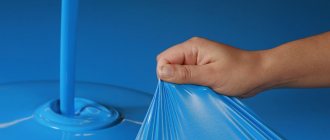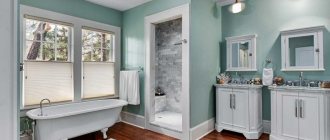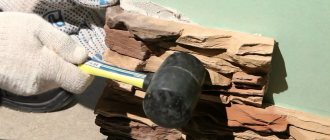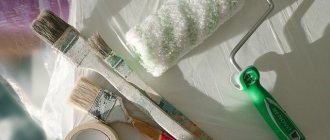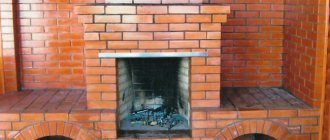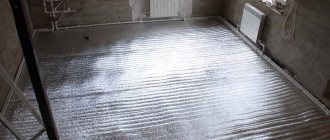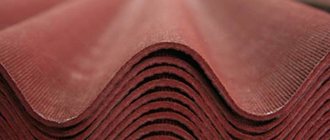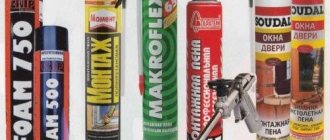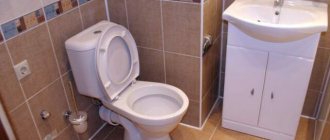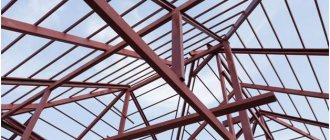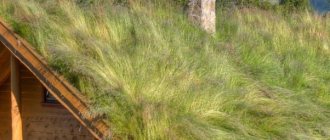Metal, metal tile and slate roofs require periodic painting, which not only improves the appearance of the structure, but also extends its service life, since the procedure is a good prevention of corrosion. Properly selected rubber roof paint makes it possible to avoid replacing this part of the building.
Description of rubber paint
Rubber roofing paint is a paint and varnish product based on acrylic water dispersion with the addition of latex and other ingredients. Its peculiarity lies in the fact that a universal flexible layer is created. It, like roofing sealants, protects the surface, but at the same time gives it a beautiful appearance.
This paint does not contain organic solvents, therefore it is safe for the environment and humans. Toxic substances are not released, there is no unpleasant odor.
Types of paint
This paint gets its name from its property of becoming a soft film reminiscent of rubber. It is similar to polymer mastic, which is used for self-leveling floors.
Standard paints and varnishes do not have this property, and after drying they become hard.
There are several types of rubber paint. Depending on the scope of application, the following are distinguished:
- For outdoor work. According to its performance characteristics, it is suitable for use in extreme conditions, with sudden temperature changes. This type is recommended for roofing. It can also be used on sports grounds, in swimming pools, for external walls and plinths.
- For interior work. It is suitable for floors, windows, interior walls, various objects. It can only be used in a dry room - it is not suitable for the street.
- For wood. Such compositions contain fungicidal and antiseptic additional components. Thanks to this, this acrylic coating protects the wooden surface from mold, mildew, and microbes. The product will not rot.
- Car paint. Used for processing metal bodies. The composition has increased wear resistance and a large assortment of colors. Can also be applied to interior parts and wheel rims.
Compound
The properties of rubber paint are determined by its composition. It contains the following components:
- Acrylic latex. It makes the material strong and flexible.
- Preservative. It is used to ensure a longer service life.
- Antifreeze. Thanks to it, the composition can be used for outdoor work. In addition, the layer remains flexible and elastic, even if the temperature drops to -50°C.
- Coalescent. This substance is used to form a film.
- Water. Used as a solvent.
- Chemical additives. Dyes and various substances are used that add shine or dullness.
Volume and form of release
Rubber paint is sold as a liquid in buckets, cans, aerosols and drums. Available in containers of 1.2 kg (about 1 l), 3.5 kg (2.5 l) and 6 kg (4 l). There are also larger containers - 12, 14 and 40 kg.
Aerosol paint is the most expensive, but this option is considered the most convenient. There are cans of 325, 390, 450 and 520 ml.
Colors
Paint in black and white shades is universal. It is diluted with other colors to obtain different shades, even the most unusual ones. Many companies produce ready-made colors: green, blue, yellow, red, etc.
Standardly, the line contains from 5 to 15 tones. For painting buildings there is a special product with a crumb effect. For cars they produce many more options - with metallic, mother-of-pearl, glossy and matte, with shimmer, luminous.
Storage and transportation conditions
The paint should be stored at temperatures from 0 to +40°C. The container must be tightly closed. This applies to both new products and used remnants. During transportation, freezing for a short period is allowed, but only to a maximum of -20°C. Afterwards you need to keep the paint in a warm place for a day, then you can use it.
What materials can be used to coat concrete?
An example of painting a concrete coating to protect it from abrasion.
The concrete base is a multi-layer structure that has good technical characteristics and “zero” decorative effect. To make it suitable for use, additional surface treatment is required, which would eliminate such drawbacks of the floor as the tendency to generate dust and absorb moisture. What materials are used to improve the technical and decorative properties of the floor?
- polymer impregnation;
- paints;
- putty;
- liquid glass;
- sealant.
The liquid composition, which is applied to the concrete surface, significantly reduces the porosity of the structure. This affects the following gender indicators:
- water absorption level;
- degree of sound insulation;
- susceptibility to chemical and mechanical damage;
- tendency to develop microorganisms (mold, fungus).
Additional protection significantly extends the life of the concrete floor. To understand which type of paint and varnish material is preferable to use, let’s consider the above-mentioned products in more detail.
Preparation and application
Preparatory work is important as it reduces the risk of the composition peeling off from the base being treated.
Cleansing
Before applying rubber paint, it is important to prepare the surface. First you need to carry out mechanical cleaning, that is, remove dust, debris, dirt, mold. Rust must also be cleaned off. If there was another covering before, it is removed. If there are defects, they need to be eliminated. This applies to chips, cracks, and small holes. They can be puttied and then sanded with fine-grained sandpaper. The ridges need to be sanded down to completely remove the ridges.
If the roof is metal, then it is degreased. To do this, you can use dishwashing detergent, any soap or special solvents. If the base is glossy, then it is sanded so that the paint adheres better.
Primer
Before priming, iron and other metal products must be coated with agents that prevent the formation of corrosion. Then you can make the next layers.
An insulating type primer is used. The substance should be applied with a brush or roller. It is recommended to treat parts made of concrete or cement, as well as other porous materials, twice.
For wood, use a silicone-acrylic primer. For other bases, a universal latex or acrylic type of coating is used. If the surface will often be exposed to snow and rain, it is recommended to make a layer of hydrophobic soil.
Characteristics
Before choosing a suitable product, you need to carefully assess the condition and serviceability of the floor.
Before applying a polymer coating to a concrete floor, you should find out:
- purpose of the structure;
- type of loads exerted on the surface;
- technical condition of the monolithic floor;
- decorative design options;
- conditions under which the object is used.
Polymer paints are a powdery substance that performs the protective function of the surface material on which it is applied from the negative effects of destructive factors. In addition, some types of paints with the addition of auxiliary substances - coloring pigments, create a special aesthetic appearance for nondescript gray monolithic surfaces, giving them bright colors.
The polymer coating for concrete floors also contains the following components:
This substance is made with the addition of plasticizing components.
- dyes;
- fillers;
- solvents;
- hardeners;
- plasticizing impurities;
- products for diluting substances;
- other constituent particles.
Rules for applying paint to a metal roof
The rules for applying rubber paint differ slightly from other varieties. Much depends on the material from which the roof is made.
Painting a new roof
The metal parts of the roof need to be cleaned. Remove all debris and wash the surface. You only need to apply paint to a dry roof, so after washing you need to wait until it dries. The paint is not applied at low temperatures, as stated in the instructions.
If the sheets are galvanized, they can be painted immediately. No pre-treatment required. If black iron sheets are used, it is recommended to first apply a primer, which will protect the metal from the influence of water. Make 2 layers, each of them must dry before applying the next. Depending on the air temperature, the procedure takes 2-6 hours. This painting stage can take a day.
Painting an old roof
If the roof is old, then it is important to properly prepare it for painting. The following activities are required:
- Inspect the surface for rust.
- Determine the extent of corrosion. In severe cases, repairs are required.
- Rusty areas must be removed with a brush or a special grinder.
- Remove debris and dirt.
- Rinse with water and dry.
- Treat with a primer regardless of what metal was used.
A day after using the primer, apply rubber paint. It is best to do 2 layers.
How to apply paint
Paint on the roof should be applied with the same tools as on any other product. Use special rollers, sprayers, and brushes. The latter option takes longer, and the material is greatly consumed. Using a roller is also not economical.
The sprayer will do everything quickly and consume little material. But you need to take into account that rubber paint in its pure form cannot be applied with such a device. To do this, it must be diluted. Use special products recommended by the manufacturer of the selected paint.
Concrete floor protection
The concrete base of the floor loses its strength after a certain time. The reason for this is temperature changes, as a result of which microcracks form in the concrete, and soon - potholes. To avoid this result, after hardening the concrete must be treated with appropriate mixtures or paints. As a result, the floor will be cleared of dust and the pores of the material will be clogged, which will help improve the overall condition of the coating and increase its technical performance.
Slate painting
A slate roof is painted just to improve its appearance. To do this, it is better to use acrylic or silicone enamels and paints. You can use an organic type solvent or a water-based product. But the first option has a number of advantages:
- the film that forms on the surface is durable;
- there is a moisture-repellent effect;
- high flexibility;
- resistance to ultraviolet rays;
- longer color retention.
The disadvantage of using organic type solvents is that there is a pungent odor, but this will quickly disappear when the layer dries. But this feature is not significant for outdoor work.
The slate needs to be treated with a primer that will close the pores. It is best to apply paint with a swing-type brush with a stiff brush. A roller will not work when processing slate. It is much easier to paint the slate if it lies on the ground, and then only install it.
Recommendations for finishing a concrete floor
The topcoat should be applied to the prepared substrate. It is recommended to choose paint based on the type of room and its functional purpose. For places with possible mechanical damage and heavy loads, it is better to use paints with high wear resistance to ensure greater strength and reliability.
Thin-layer self-leveling cladding is treated with varnish components for a concrete base or polyurethane enamel. If we talk about how to cover a concrete floor in a garage, it is best to choose products based on epoxy enamels and solvents.
To correctly determine what to cover a concrete floor with, it is important to take into account all the technical characteristics of the material, the characteristics of the room and climatic conditions. You also need to pay attention to the cost of the coating, since in addition to the price of the material itself, you also need to calculate the installation costs if the finishing work is not carried out independently, but with the involvement of specialists.
How to dust a floor: the cheapest ways (2 videos)
Various products for coating concrete (37 photos)
Paint consumption and surface care
Rubber paint is economical. The cost of liquid material depends on the type of base. For example, to process galvanized or iron sheets you will need about 250 g per 1 sq.m. For concrete, brick and plastered surfaces, about 400 g are required, and for wooden surfaces - 350 g. For slate, 450 g are required, and if the base has been previously painted, then only 150 g is consumed.
Wet cleaning of the surface can begin a week after it has dried. During this time, the layer of rubber paint acquires the necessary properties. Chemical aggressive compounds cannot be used.
To paint or not to paint
Paint. Painting a slate roof allows you to solve several problems in one fell swoop:
- Reduce roof moisture absorption to almost zero. Thus, we will reduce the load on the rafter system and significantly extend the service life of the slate: the water in its pores, freezing when the temperature drops, sharply accelerates the destruction of the sheet;
- Give the roof a much more attractive appearance. Gray slate looks, admittedly, rather dull;
- Do not allow the slate to become overgrown with moss and mold. Both problems are typical with older roofs;
The photo demonstrates the seriousness of the problem.
- Prevent ridge corrosion.
Let us remind you: the ridge purlin of a slate roof is closed on top with a ridge made of galvanized iron. Despite the zinc layer, after one or two decades it usually begins to rust. Paint creates an additional barrier against rust.
